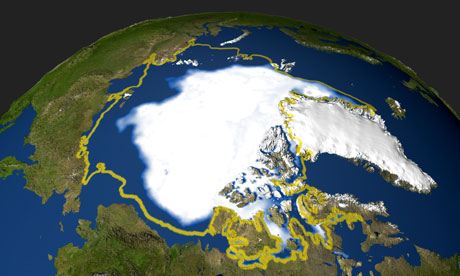Melting ice caps open up Arctic for 'white gold rush'
As rising temperatures expose more land for exploration, prospectors are rushing to the far north in the hope of carving out a new mineral frontier

A satellite image showing the minimum concentration of Arctic sea ice in 2005. The yellow outline indicates where the concentration of ice was in September 1979. Photograph: NASA/AFP/Getty Images
The crumpled figure in seat 22 on the Air Greenland flight from Ilulissat to Kangerlussuaq was no Indiana Jones. But Dennis Thomas, a mining engineer viewing gold and diamond prospects in the Arctic, was happy to play up the part. "I've been shot at and involved in all sorts of other scrapes," the 62-year-old said as the plane cruised at 11,000 ft.
Thomas had spent 30 years scouring Latin America, the Far East and most other points around the globe, but this was his first time in Greenland. And it will not be his last. The Briton was impressed with what he had seen and said he would be back after discussions with various mining companies and investors who pay him a "finder's fee" for putting them on to new, commercially viable, deposits.
"This is a very exciting place … There is only one working mine but in 10 years I would like to see them with half a dozen serious mines," he said.
It is not just small operations like Thomas Mining Associates, based in West Sussex, that are newly on the hunt as ice caps melt in the far north. Major companies have recently set foot in Greenland hoping to carve out – literally – a new mineral frontier. Political visits from countries such as China are also on the rise. They are being driven by the insatiable demand for a variety of precious stones and other commodities, which has driven up prices and sent prospectors on a frantic search for new supplies.
Greenland has long been known to harbour everything from uranium – needed for nuclear plants – to so-called rare earth minerals used in hardware such as mobile phones, flatscreen TVs and modern weaponry.
The Arctic was largely off-limits because much of the land was considered unworkable, buried under hundreds of metres of snow and ice, and with nothing in the way of traditional infrastructure. Global warming has changed that picture.
While Greenland's traditional way of hunting wild animals is endangered by the melting ice cap, mineral mining is entering a new, potentially lucrative chapter. More and more of the land is becoming ice-free – unleashing greenhouse gases in the process but offering new opportunities for diggers in the "white gold rush".
New mining applications are being submitted for extraction, all the way from Canada through Greenland to Finland. The Greenland government in Nuuk has just underlined its commitment to new ventures by repealing a law that prevented any kind of uranium mining. The laws have been amended to grant exploration licences for radioactive elements such as uranium and thorium on a case-by-case basis.
It benefits firms such as Australian-owned mining company Greenland Minerals & Energy Ltd (GMEL). Lars Emil Johansen, who recently retired as chairman of the company's Greenland subsidiary, and was Greenland's second prime minister, said: "It's not permission to start mining, but it is permission to make studies for mines with uranium. It's a very big step forward for the company."
This is happening at Kvanefjeld – said by GMEL to be "one of the world's most exciting emerging mineral projects" and believed to hold the world's sixth-largest uranium deposit.
There are also plans to open up uranium exploration in the far north of Canada, Russia, and Finland.
Uranium is controversial because of the potential health risks associated with its extraction, plus wider issues associated with its use in nuclear weapons and atomic power stations.
Meanwhile, one of the world's biggest gold mines was recently opened at Kittilä in the far north of Finland and others are already being planned in that country. Yet there is conflict over some of the plans. For example, there is vociferous opposition to a scheme by mining companies, including Anglo American, to produce gold and copper at the Pebble Mine in Alaska. Campaigners say such plans threaten the nearby Bristol Bay watershed, which supports the world's most productive wild sockeye salmon fishery, critical to the state's economy and the livelihoods of many Alaskan native communities.
So far the only current mining operation in Greenland is the Nalunaq gold mine in the south of the country. It was restarted this year as a going concern by its owner, Angel Mining, registered in London. It has created jobs and little opposition but there is more concern over a much larger industrial plan.
Alcoa, the world's third largest aluminium producer, is working on a scheme to build a massive smelter in Greenland. It hopes to use hydroelectric power as a cheap, green form of energy and produce a replica of the Fjardaál ("aluminium of the fjords") smelter at Reydðarfjörður in eastern Iceland.
Henrik Stendal, head of the geology department at the Bureau of Minerals and Petroleum in Nuuk, Greenland, says he is hopeful there will an increasing amount of activity in his country. This is not least because rising temperatures mean there is more land to explore now. He spells out something that many in government think privately but are reluctant to say openly: "You could say global warming is good for Greenland."








No comments:
Post a Comment